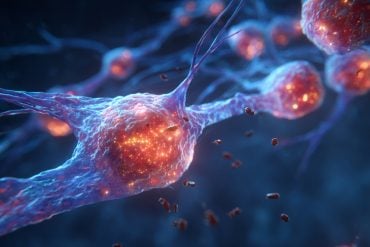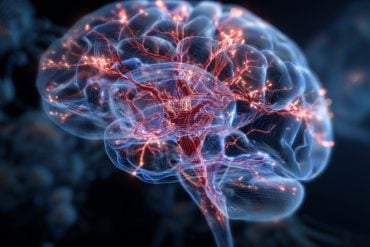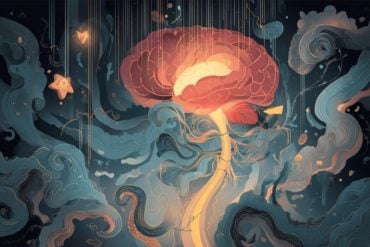Summary: Researchers uncovered a crucial link between glucose levels, serotonin signaling, and fertility. By studying rats and goats, the team discovered that increased glucose availability stimulates serotonergic neurons, enhancing the release of reproductive hormones via the activation of kisspeptin neurons.
This finding not only deepens our understanding of reproductive health but also suggests potential treatments for fertility issues in people with depression. The research highlights the significant role of diet and serotonin in maintaining reproductive function and offers a new avenue for addressing depression-related infertility using SSRIs.
Key Facts:
- Glucose and Serotonin Interaction: Elevated glucose levels in the brain stimulate serotonin release, which in turn activates kisspeptin neurons crucial for reproductive hormone release.
- Implications for Reproductive Health: The study explains the biological mechanism behind fertility issues related to poor nutrition and provides insights into the decreased fertility observed in individuals with depression.
- Potential Treatments: The findings suggest that SSRIs, commonly used to treat depression, could also enhance fertility by improving serotonergic signaling, offering a dual-purpose treatment strategy.
Source: Nagoya University
Scientists from Nagoya University in Japan have clarified the relationship between energy levels and fertility in animals and humans. They identified signaling from serotonin neurons as important for maintaining reproductive function by sensing glucose availability and subsequently enhancing the release of the reproductive hormone gonadotropin.
Their findings also provide an explanation and possible treatment for the decreased fertility observed in people with depression.
The results were published in Scientific Reports.

People who lack sufficient nutrition encounter problems with their reproductive health. For example, ballet dancers can experience menstrual disruptions and women who fast can struggle to conceive.
According to a new study led by Designated Associate Professor Sho Nakamura and Professors Hiroko Tsukamura and Satoshi Ohkura, one of the main factors that affect a person’s reproductive health is glucose availability.
Nakamura, Tsukamura, and their colleagues from the Graduate School of Bioagricultural Sciences at Nagoya University discovered that elevated glucose availability in rat brain stimulates serotonergic neurons.
This causes the release of serotonin in the brain. Serotonin is an important neurotransmitter that affects the body and mind. It influences functions such as mood and behavior, and physiological processes such as bone health and metabolism.
When the researchers administered serotonin to goat brains, it triggered the activation of the kisspeptin neurons, which are the primary stimulator for the release of key reproductive hormones, such as gonadotropin-releasing hormone and gonadotropins.
“We used rats and goats as models because rats are a useful human model, whereas goats serve as a livestock model,” said Professor Ohkura.
Their findings indicate that serotonergic neurons can release serotonin when they sense high levels of glucose. By interacting with serotonin receptors in the kisspeptin neurons, they can improve reproductive functions.
The use of inhibitors for serotonergic signaling also allowed the researchers to establish that the opposite was true. This important finding sheds light on why mammals with a poor diet face problems associated with fertility.
Depression can often be attributed to malfunctioning serotonergic neurons in the brain, which are often targeted for treatment. The dysfunction of serotonin neurons often observed in individuals with depression suggests that low serotonergic activity might be a part of its cause.
Nakamura’s research lays the groundwork for treating depression-induced infertility in humans and reproductive disorders in livestock, which implies a possible underlying connection and a potential treatment.
“Since selective serotonin reuptake inhibitors (SSRIs) are commonly prescribed to treat depression in patients, studies indicate that these drugs may also have potential benefits for addressing depression-related infertility and treating animals,” said Professor Tsukamura, the Principal Investigator of the research group and corresponding author of the paper.
She proposes that SSRIs could potentially be used in the future for human and animal reproduction, or in combination with diet treatments for people with depression.
About this neuroscience and fertility research news
Author: Matthew Coslett
Source: Nagoya University
Contact: Matthew Coslett – Nagoya University
Image: The image is credited to Neuroscience News
Original Research: Open access.
“Raphe glucose-sensing serotonergic neurons stimulate KNDy neurons to enhance LH pulses via 5HT2CR: rat and goat studies” by Sho Nakamura et al. Scientific Reports
Abstract
Raphe glucose-sensing serotonergic neurons stimulate KNDy neurons to enhance LH pulses via 5HT2CR: rat and goat studies
Dysfunction of central serotonergic neurons is known to cause depressive disorders in humans, who often show reproductive and/or glucose metabolism disorders.
This study examined whether dorsal raphe (DR) serotonergic neurons sense high glucose availability to upregulate reproductive function via activating hypothalamic arcuate (ARC) kisspeptin neurons (= KNDy neurons), a dominant stimulator of gonadotropin-releasing hormone (GnRH)/gonadotropin pulses, using female rats and goats.
RNA-seq and histological analysis revealed that stimulatory serotonin-2C receptor (5HT2CR) was mainly expressed in the KNDy neurons in female rats.
The serotonergic reuptake inhibitor administration into the mediobasal hypothalamus (MBH), including the ARC, significantly blocked glucoprivic suppression of luteinizing hormone (LH) pulses and hyperglycemia induced by intravenous 2-deoxy-D-glucose (2DG) administration in female rats.
A local infusion of glucose into the DR significantly increased in vivo serotonin release in the MBH and partly restored LH pulses and hyperglycemia in the 2DG-treated female rats.
Furthermore, central administration of serotonin or a 5HT2CR agonist immediately evoked GnRH pulse generator activity, and central 5HT2CR antagonism blocked the serotonin-induced facilitation of GnRH pulse generator activity in ovariectomized goats.
These results suggest that DR serotonergic neurons sense high glucose availability to reduce gluconeogenesis and upregulate reproductive function by activating GnRH/LH pulse generator activity in mammals.






